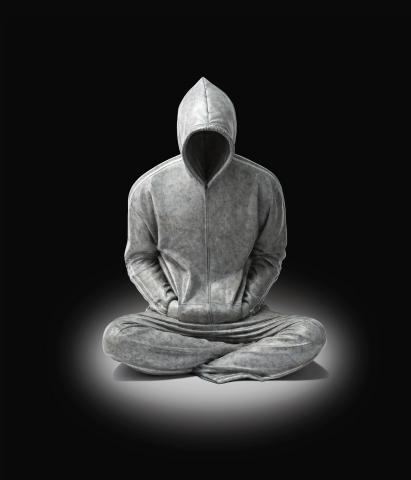SOLOIST, 2012
ALEX SETON
bronze
95.0 x 75.0 x 70.0 cm
signed, dated, inscribed and numbered at base: Alexander Seton / ‘SOLOIST’ 2012 / ED. 1/3
Sullivan + Strumpf, Sydney
Private collection, Sydney
Wynne Prize, Art Gallery of New South Wales, Sydney, 23 March – 2 June 2013 (another example)
National Artist Self Portrait Award 2013, University of Queensland Art Museum, 19 October – 16 February 2013, Winner: People’s Choice Award (another example)
Capon, E., Fairley, G., Ostrow, S., Britton, K., Alex Seton: Roughing Out, Hazelhurst Regional Gallery and Arts Centre, Gymea, 2013, pp. 14, 15 (illus. marble version)
Belonging to a series of sculptures named ‘Elegy on Resistance’, Soloist, 2012 is one of Alexander Seton’s most clearly figurative works. A large sculpture featuring a hooded and slouched figure, Soloist is presented simply within the gallery space. Adopting a cross-legged meditative pose, the lifelike figure is unobtrusive and exudes an eerie calmness. Based on the marble version of Soloist, Seton cast a small edition of sculptures in bronze, one of which was exhibited as a finalist in the 2013 Wynne Prize at the Art Gallery of New South Wales.
Sydney sculptor, Seton has risen rapidly from graduate shows to survey exhibitions and international art fairs. A skilled craftsman and astute observer of contemporary society, Seton has carved a niche for himself by creating highly detailed replicas of prosaic items of consumer culture in marble and bronze, transforming them into a series of elegant physical paradoxes. Seton has frequently demonstrated his prowess in sculpting fabric, inviting parallels with the ancient masters of his craft. Recently, Seton’s works have been put to the service of environmental and societal activism, addressing topical issues such as surveillance, climate change and Australia’s treatment of asylum seekers.
Seton’s preference for the noble materials of sculpture, historically linked to acts of commemoration, endows his works with an elegiac tone. In this context, Soloist becomes a potent monument to contemporary urban ‘otherness’. Dressed in an ubiquitous hoodie, the controversial uniform of urban youth, the figure itself is curiously both present and absent. While the physical presence of the hooded figure is undeniable, stoic and defiant in his weight and immobility, the body within is missing. We are left searching for the physical individual, and in its absence forced to project our own identity onto its sculpted form. Lending conceptual depth to Seton’s technical prowess, this corporeal absence elevates the figure of Soloist to a collective symbol. It is everyone and no-one, a figure of contemporary urban anonymity, yet also expressing the overlooked power and quiet strength of the individual. Cross-legged and unmoving, this cast bronze figure evokes the power of historical acts of individual activism, media images of which have remained present in our psyche.
The work’s title emphasises the role of the figure as both the central performer and sole focus of this scene, yet still he remains invisible to our gaze. The theatrical nature of Seton’s installation places the viewer in a position of passive and impotent observation, similar to the position one adopts with respect to mass-media. This effect was further emphasised in Seton’s installation of the work at the ArtHK 12 in Hong Kong, where the marble version of Soloist was surrounded and surveyed by marble replicas of CCTV cameras, Quartet 1-4. Thus, Seton opens up a complex dialectic between observation and identification, between the viewer and the viewed, shedding light on the uncomfortable realities of surveillance and security.
Already well-known to Australian audiences and attracting critical acclaim overseas (he was one of the recent recipients of the 2015 François Schneider Foundation Contemporary Talents prize), Seton is a contemporary artist whose work has rarely appeared on the secondary market.
LUCIE REEVES-SMITH
